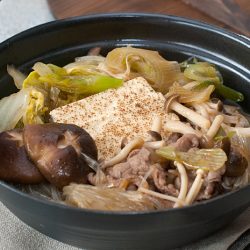Sukiyaki (Japanese Beef Hot Pot)

Get this recipe on the next page >>
Sukiyaki (鋤焼/すき焼き) is a Japanese dish in the nabemono (Japanese hot pot) style. It consists of thinly sliced beef with other ingredients such as tofu, negi, mushrooms, jelly noodles and cabbage.
See Also: Shabu Shabu Recipe
The sauce is made up of sake, mirin, sugar and soy. When eating, Japanese often dip the ingredients in raw beaten egg. Cooked udon or soba is added at the end to soak up the remaining broth. It is extremely easy to whip up at home and a perfect dish for beginner cooks. It’s always quite expensive when one orders it at Japanese restaurants with a few measly slices of beef, so making it at home is affordable (with better quality of beef) and effortless.
Cooking with Dog video for Sukiyaki on YouTube
Recently, I have been hooked on cooking Japanese, largely because I was inspired by Cooking with Dog, a cooking channel on YouTube. The tagline of the show reads “It’s not what you think” – i.e. it’s not cooking with dog meat, but cooking with a dog as your host – the videos are narrated by a male poodle named Francis in perfect Japanese-accented English. While the chef (a human, in case you are wondering) is demonstrating how to cook the dish, Francis sits obediently behind the counter as he “voice overs” the steps of cooking. He sounds earnest and sincere with encouraging words such as “It’s so easy, even a dog can do it” (aww). With so many cooking videos out there, trust the Japanese to be one step ahead in terms of creativity in their presentation to stand out among the rest. Of course, this wackiness will not hold on its own had the recipes not been rock solid good – the steps are clear and the dish is always beautifully presented. I felt so inspired that I finished all the videos within 2 days. The first dish I tried out was this Sukiyaki.

Sukiyaki (Japanese Beef Hot Pot) Recipe
This is an easy one-pot Japanese meal.
Ingredients:
- 200g thinly sliced beef
- 1 organic raw egg for dipping optional
- 200g napa cabbage sliced
- 100g shungiku (Japanese garland chrysanthemum/locally known as “tang oh”)
- 150g seared firm tofu, sliced
- ito konnyaku or shirataki noodles (jelly-like noodles) cooked in boiling water for 2 minutes, then plunged in ice water bath for a few minutes and drained
- 1 stalk negi (Japanese scallion) sliced thinly and diagonally
- 4 shiitake mushrooms stalk removed, then make a 6-star flower cut on the mushroom cap
- enoki mushrooms or hon shimeji ends trimmed
- cooked udon or soba noodles
(A) Sukiyaki Sauce (P.S. I doubled the quantity stated in the original recipe)
- 100ml sake
- 50ml mirin
- 50ml light soy sauce
- 2 tbsp sugar
Directions:
- Bring the ingredients at (A) to a simmer. Set aside.
- In a wide & shallow sukiyaki pot, add beef and a few tablespoons of sukiyaki sauce. Push the beef to one side. Add the other ingredients and the remaining sukiyaki sauce. Cover with lid and simmer for a few minutes.
- When serving, you may dip the ingredients in raw beaten egg. Add cooked udon or soba noodles at the end to soak up the remaining broth.
Noob Cook Tips
1. Ingredients substitution- Japanese seared tofu: any type of firm tofu; shungiku: any dark leafy greens; ito konnyaku or shirataki noodles: local tang hoon/glass noodles (soak in water before adding at the last step); negi: large spring onions (the type that resembles leeks) or regular spring onions.
2. Do not place ito konnyaku near the beef as the calcium contained in the noodles may make beef tough.
